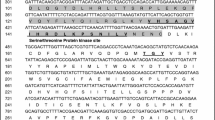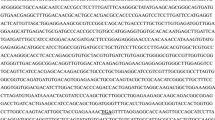Abstract
Glycerol-3-phosphate dehydrogenase (GPDH) catalyzes the conversion of dihydroxyacetone phosphate (DHAP) to glycerol-3-phosphate (G3P) and plays a central role in the synthesis of glycerol and triacylglycerides (TAGs). Osmotic stress has been shown to induce the accumulation of glycerol and TAGs in the green microalga Chlamydomonas reinhardtii. In a previous study, we identified three GPDH homologs (CrGPDH1, CrGPDH2, and CrGPDH3) in this microalga. We found that CrGPDH2 and CrGPDH3 were expressed in response to 200 mM NaCl treatment, suggesting that these two genes play roles in glycerol and TAGs synthesis and in osmotic stress tolerance. In this study, we report on the functional characterization of CrGPDH2 and CrGPDH3. A concentration of NaCl as low as 5 mM for 5 min was sufficient to induce the expressions of both genes. We mapped the cDNA ends of CrGPDH2 and CrGPDH3 using RLM-RACE and cloned their full-length cDNAs. The expression of these two cDNAs in the Saccharomyces cerevisiae gpd1Δgpd2Δ double mutant confirmed that both CrGPDH2 and CrGPDH3 have GPDH activity. The genetic complementation analysis revealed that CrGPDH2 and CrGPDH3 were able to restore glycerol production and rescue the salt sensitivity of this mutant. Compared with CrGPDH3, CrGPDH2 conferred higher glycerol production and greater salt tolerance when expressed in the gpd1Δgpd2Δ double mutant. Together, these findings show that CrGPDH2 and CrGPDH3 encode functional homologs of the S. cerevisiae GPD1 gene that is involved in glycerol synthesis and osmotic stress tolerance.





Similar content being viewed by others

References
Ansell R, Granath K, Hohmann S, Thevelein JM, Adler L (1997) The two isoenzymes for yeast NAD+-dependent glycerol-3-phosphate dehydrogenase encoded by GPD1 and GPD2 have distinct roles in osmoadaptation and redox regulation. EMBO J 6:2179–218
Avron M (1986) The osmotic components of halotolerant algae. Trends Biochem Sci 11:5–6
Ben-Amotz A, Avron M (1983) Accumulation of metabolites by halotolerant algae and its industrial potential. Annu Rev Microbiol 37:95–119
Cai M, He L-H, Yu T-Y (2013) Molecular clone and expression of a NAD+-dependent glycerol-3-phosphate dehydrogenase isozyme gene from the halotolerant alga Dunaliella salina. PLoS ONE 8:1–8
Chen X, Fang H, Rao Z, Shen W, Zhuge B, Wang Z, Zhuge J (2008) Cloning and characterization of a NAD+-dependent glycerol-3-phosphate dehydrogenase gene from Candida glycerinogenes, an industrial glycerol producer. FEMS Yeast Res 8:725–734
Chen H, Lao YM, Jiang JG (2011) Effects of salinities on the gene expression of a (NAD+)-dependent glycerol-3-phosphate dehydrogenase in Dunaliella salina. Sci Total Environ 409:1291–1297
Galafassi S, Toscano M, Vigentini I, Piškur J, Compagno C (2013) Osmotic stress response in the wine yeast Dekkera bruxellensis. Food Microbiol 36:316–319
Gancedo C, Gancedo JM, Sols A (1968) Glycerol metabolism in yeasts: pathways of utilization and production. Eur J Biochem 5:165–172
Ghoshal D, Mach D, Agarwal M, Goyal A (2002) Osmoregulatory isoform of dihydroxyacetone phosphate reductase from Dunaliella tertiolecta: purification and characterization. Protein Expr Purif 24:404–411
Harris EH (1989) The Chlamydomonas sourcebook, a comprehensive guide to biology and laboratory use. Academic, San Diego
He QH, Qiao DR, Bai LH, Zhang QL, Yang WG, Li Q, Cao Y (2007) Cloning and characterization of a plastidic glycerol 3-phosphate dehydrogenase cDNA from Dunaliella salina. J Plant Physiol 164:214–220
He Y, Meng X, Fan Q, Sun X, Xu Z, Song R (2009) Cloning and characterization of two novel chloroplastic glycerol-3-phosphate dehydrogenases from Dunaliella viridis. Plant Mol Biol 71:193–205
Herrera-Valencia VA, Macario-González LA, Casais-Molina ML, Beltran-Aguilar AG, Peraza-Echeverría S (2012) In silico cloning and characterization of the glycerol-3-phosphate dehydrogenase (GPDH) gene family in the green microalga Chlamydomonas reinhardtii. Curr Microbiol 64:477–485
Hohmann S (2002) Osmotic stress signaling and osmoadaptation in yeasts. Microbiol Mol Biol Rev 66:300–372
Husic HD, Tolbert NE (1986) Effect of osmotic stress on carbon metabolism in Chlamydomonas reinhardtii. Plant Physiol 82:594–596
Kozak M (1986) Point mutations define a sequence flanking the AUG initiator codon that modulates translation by eukaryotic ribosomes. Cell 44:283–292
Lee DH, Myoung-Dong K, Yeon-Woo R, Jin-Ho S (2008) Cloning and characterization of CmGPD1, the Candida magnoliae homologue of glycerol-3-phosphate dehydrogenase. FEMS Yeast Res 8:1324–1333
Lenassi M, Zajc J, Gostincar C, Gorjan A, Gunde-Cimerman N, Plemenitas A (2011) Adaptation of the glycerol-3-phosphate dehydrogenase Gpd1 to high salinities in the extremely halotolerant Hortaea werneckii and halophilic Wallemia ichthyophaga. Fungal Biol 115:959–970
León R, Galván F (1994) Halotolerance studies on Chlamydomonas reinhardtii: glycerol excretion by free and immobilized cells. J Appl Phycol 6:13–20
Mumberg D, Müller R, Funk M (1995) Yeast vectors for the controlled expression of heterologous proteins in different genetic backgrounds. Gene 156:119–122
Peng F, Li G, Wang X, Jiang Y, Yang Y (2010) Cloning and characterization of a glycerol-3-phosphate dehydrogenase (NAD+) gene from the halotolerant yeast Pichia farinosa. Yeast 27:115–121
Siaut M, Cuiné S, Cagnon C et al (2011) Oil accumulation in the model green alga Chlamydomonas reinhardtii: characterization, variability between common laboratory strains and relationship with starch reserves. BMC Biotechnol 11:2–15
Vigeolas H, Waldeck P, Zank T, Geigenberger P (2007) Increasing seed oil content in oil-seed rape (Brassica napus L.) by over-expression of a yeast glycerol-3-phosphate dehydrogenase under the control of a seed-specific promoter. Plant Biotechnol J 5:431–441
Watanabe Y, Tsuchimoto S, Tamai Y (2004) Heterologous expression of Zygosaccharomyces rouxii glycerol-3-phosphate dehydrogenase gene (ZrGPD1) and glycerol dehydrogenase gene (ZrGCY1) in Saccharomyces cerevisiae. FEMS Yeast Res 4:505–510
Acknowledgments
This research was supported by the Consejo Nacional de Ciencia y Tecnología (CONACYT, México) Project No. 169217. Melissa Lessen Casais-Molina received support from CONACYT (Scholarship No. 228280). The authors thank Professor Peter Dahl for generously providing S. cerevisiae W303-1A and the gpd1Δgpd2Δ double mutant and Ileana C. Borges Argáez and Mildred Carrillo Pech for the technical support.
Author information
Authors and Affiliations
Corresponding author
Rights and permissions
About this article
Cite this article
Casais-Molina, M.L., Peraza-Echeverria, S., Echevarría-Machado, I. et al. Expression of Chlamydomonas reinhardtii CrGPDH2 and CrGPDH3 cDNAs in yeast reveals that they encode functional glycerol-3-phosphate dehydrogenases involved in glycerol production and osmotic stress tolerance. J Appl Phycol 28, 219–226 (2016). https://doi.org/10.1007/s10811-015-0588-3
Received:
Revised:
Accepted:
Published:
Issue Date:
DOI: https://doi.org/10.1007/s10811-015-0588-3



